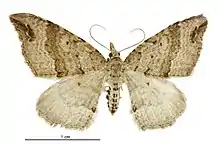Homodotis falcata
Homodotis falcata is a moth of the family Geometridae.[3] It is endemic to New Zealand and is found in the southern part of the South Island. The larvae of this species feed on leaf litter and adults are on the wing for most months of the year. The forewings of this species can vary in depth of colour.
| Homodotis falcata | |
|---|---|
 | |
| Female | |
 | |
| Male | |
| Scientific classification | |
| Domain: | Eukaryota |
| Kingdom: | Animalia |
| Phylum: | Arthropoda |
| Class: | Insecta |
| Order: | Lepidoptera |
| Family: | Geometridae |
| Genus: | Homodotis |
| Species: | H. falcata |
| Binomial name | |
| Homodotis falcata | |
| Synonyms[2] | |
| |
Taxonomy
This species was first described in 1879 by Arthur Gardiner Butler and tentatively placed in the genus Larentia.[4] Butler used a male specimen collected in Dunedin by F. W. Hutton.[2] In 1883 Edward Meyrick, thinking he was describing a new species, named this species Eurydice cymosema.[2] Meyrick synonymised that name in 1884.[2] George Hudson discussed this species under the name Xanthorhoe falcata in his 1928 book The butterflies and moths of New Zealand.[5] Hudson stated that Louis Beethoven Prout believed the holotype specimen to be a large dark form of the species Asaphodes rufescens.[6][5] J. S. Dugdale agreed with Prout, pointing out in his 1988 publication, that the New Zealand Arthropod Collection holds specimens that have coloration ranging from dark, intermediate to light and as a result Dugdale synonymised Asaphodes rufescens with this species.[2] The male holotype is held at the Natural History Museum, London.[2]
Description
Butler described the male holotype specimen as follows:
Allied to L. punctilineata (which it much resembles in colour and markings), but larger and with distinctly falcate primaries; primaries reddish-brown, with the base and a broad central belt dark brown traversed by blackish lines and margined by white dots ; a black discocellular dot; external border blackish, diffused; two or three whitish subapical dots; secondaries silvery-grey with a darker waved central belt formed of parallel dark grey lines, dotted with black upon the abdominal margin, white bordered; a submarginal series of white-bordered grey spots; a marginal series of blackish dots in pairs; fringe pale reddish-brown; abdomen with dorsal pairs of black dashes on each segment ; primaries below grey with darker white-bordered central belt ; costa cream-coloured between the markings ; a zigzag white-bordered subapical dusky stria; secondaries whitish with a broad irregular central belt formed by two blackish limiting lines and two grey intermediate lines; the outer black line distinctly undulated ; a very ill-defined blackish speckled submarginal band; body below testaceous. Expanse of wings 1 inch 3 lines.[4]
H. falcata is similar in appearance to its sister species H. megaspilata but is a slightly larger moth with its forewings having a less distinct hook shape.[7] The depth of colour of the forewings of this moth can vary from specimen to specimen.[2]
Distribution
This species is endemic to New Zealand.[1] It can be found in the southern parts of the South island and occurs with its similar in appearance sister species H. megaspilata from Dunedin southwards.[7]
Behaviour

The larvae of this species feed on leaf litter.[8] Adults are on the wing most months of the year but more frequently from July to January.[9]
References
- "Homodotis falcata (Butler, 1879)". www.nzor.org.nz. Retrieved 2022-04-27.
- John Stewart Dugdale (23 September 1988). "Lepidoptera - annotated catalogue, and keys to family-group taxa". Fauna of New Zealand. Department of Scientific and Industrial Research. 14: 182. doi:10.7931/J2/FNZ.14. ISSN 0111-5383. Wikidata Q45083134.
- "Homodotis falcata (Butlera, 1879) - Biota of NZ". biotanz.landcareresearch.co.nz. Retrieved 2023-03-07.
- Arthur Gardiner Butler (1879). "On a small collection of Heterocerous Lepidoptera, from New Zealand". Cistula entomologica. 2: 501. Wikidata Q104215588.
- George Vernon Hudson (1928), The butterflies and moths of New Zealand, Illustrator: George Hudson, Wellington, p. 113, LCCN 88133764, OCLC 25449322, Wikidata Q58593286
{{citation}}: CS1 maint: location missing publisher (link) - Louis Beethoven Prout (15 August 1927). "Notes on New Zealand Geometridae". Transactions and Proceedings of the New Zealand Institute. 58: 77. ISSN 1176-6158. Wikidata Q110670763.
- Robert J. B. Hoare (2014). A Photographic Guide to Moths & Butterflies of New Zealand. Illustrator: Olivier Jean-Philippe Ball. p. 97. ISBN 978-1-86966-399-5. Wikidata Q59396160.
- "Homodotis falcata (Butler, 1879)". plant-synz.landcareresearch.co.nz. 2011. Retrieved 2023-03-07.
- Brian H. Patrick (1997). "Codfish Island moths" (PDF). The Wētā. 20: 17–20. ISSN 0111-7696. Wikidata Q110875754. Archived from the original (PDF) on 18 October 2008.